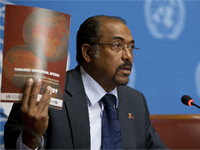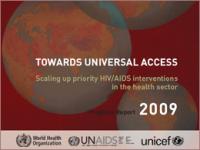Joint press release issued by WHO, UNAIDS and UNICEF

UNAIDS Executive Director presents the new WHO/UNAIDS/UNICEF report at the UN in Geneva, 30 September 2009. Credit: WHO/Christopher Black
Geneva / Paris -- More than 4 million people in low- and middle-income countries were receiving antiretroviral therapy (ART) at the close of 2008, representing a 36% increase in one year and a ten-fold increase over five years, according to a new report released today by the World Health Organization (WHO), the United Nations Children's Fund (UNICEF) and the Joint United Nations Programme on HIV/AIDS (UNAIDS).
Towards Universal Access: Scaling Up Priority HIV/AIDS Interventions in the Health Sector highlights other gains, including expanded HIV testing and counselling and improved access to services to prevent HIV transmission from mother to child.
"This report shows tremendous progress in the global HIV/AIDS response," said WHO Director-General Margaret Chan. "But we need to do more. At least 5 million people living with HIV still do not have access to life-prolonging treatment and care. Prevention services fail to reach many in need. Governments and international partners must accelerate their efforts to achieve universal access to treatment."
Treatment and Care
Access to antiretroviral therapy continues to expand at a rapid rate. Of the estimated 9.5 million people in need of treatment in 2008 in low- and middle-income countries, 42% had access, up from 33% in 2007. The greatest progress was seen in sub-Saharan Africa, where two-thirds of all HIV infections occur.
Prices of the most commonly used antiretroviral drugs have declined significantly in recent years, contributing to wider availability of treatment. The cost of most first-line regimens decreased by 10-40% between 2006 and 2008. However, second-line regimens continue to be expensive.
Despite recent progress, access to treatment services is falling far short of need and the global economic crisis has raised concerns about their sustainability. Many patients are being diagnosed at a late stage of disease progression resulting in delayed initiation of ART and high rates of mortality in the first year of treatment.
Testing and Counselling
Recent data indicate increasing availability of HIV testing and counselling services. In 66 reporting countries, the number of health facilities providing such services increased by about 35% between 2007 and 2008.
Testing and counselling services are also being used by an increasing number of people. In 39 countries, the total reported number of HIV tests performed more than doubled between 2007 and 2008.
Ninety-three percent of all countries that reported data across all regions provided free HIV testing through public sector health facilities in 2008.
Nevertheless, the majority of those living with HIV remain unaware of their HIV status. Low awareness of personal risk of HIV infection and fear of stigma and discrimination account, in part, for low uptake of testing services.
Women and Children
In 2008, access to HIV services for women and children improved. Approximately 45% of HIV-positive pregnant women received antiretroviral drugs to prevent HIV transmission to their children, up from 35% in 2007. Some 21% of pregnant women in low- and middle-income countries received an HIV test, up from 15% in 2007.
More children are benefiting from paediatric antiretroviral therapy programmes: the number of children under 15 years of age who received ART rose from approximately 198 000 in 2007 to 275 700 in 2008, reaching 38% of those in need.
Globally, AIDS remains the leading cause of mortality among women of reproductive age.
"Although there is increasing emphasis on women and children in the global HIV/AIDS response, the disease continues to have a devastating impact on their health, livelihood and survival," said Ann M. Veneman, UNICEF Executive Director.
Most-At-Risk Populations
In 2008, more data became available on access to HIV services for populations at high risk of HIV infection, including sex workers, men who have sex with men and injecting drug users.
While HIV interventions are expanding in some settings, population groups at high risk of HIV infection continue to face technical, legal and sociocultural barriers in accessing health care services.
"All indications point to the number of people needing treatment rising dramatically over the next few years," said Michel Sidibé, Executive Director of UNAIDS. "Ensuring equitable access will be one of our primary concerns and UNAIDS will continue to act as a voice for the voiceless, ensuring that marginalized groups and people most vulnerable to HIV infection have access to the services that are so vital to their wellbeing and to that of their families and communities."




